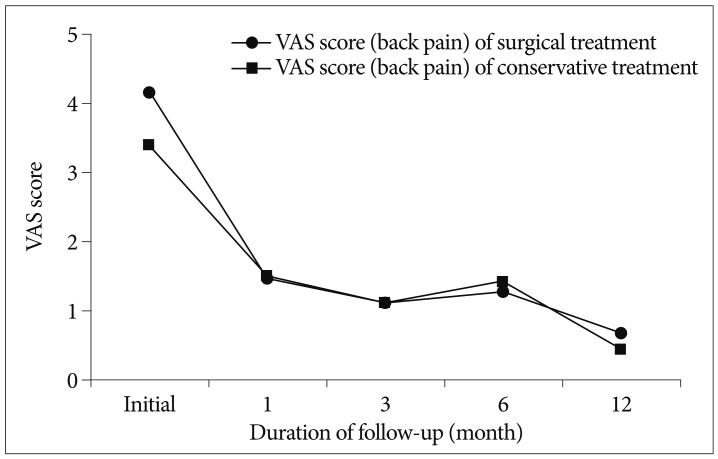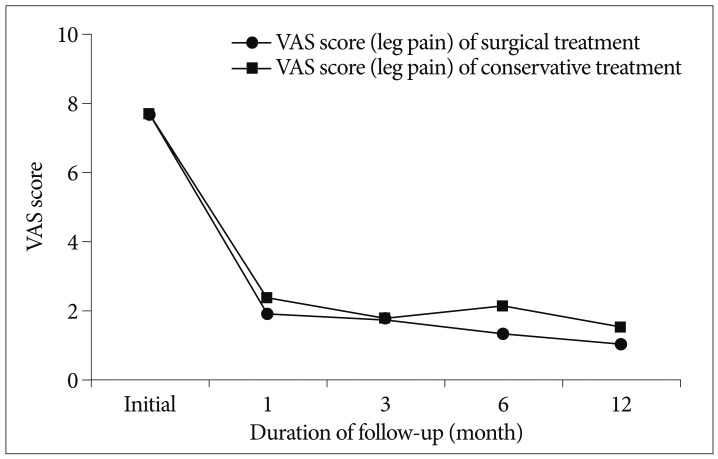J Korean Neurosurg Soc.
2013 Sep;54(3):183-188. 10.3340/jkns.2013.54.3.183.
Surgical versus Conservative Treatment for Lumbar Disc Herniation with Motor Weakness
- Affiliations
-
- 1Department of Neurosurgery, Yeungnam University College of Medicine, Daegu, Korea. sw902@yumail.ac.kr
- 2Department of Physical Medicine and Rehabilitation, Yeungnam University College of Medicine, Daegu, Korea.
- KMID: 2190895
- DOI: http://doi.org/10.3340/jkns.2013.54.3.183
Abstract
OBJECTIVE
The aim of this study is to assess outcomes during first one year for patients with severe motor weakness caused by lumbar disc herniation that underwent surgical or nonsurgical treatment.
METHODS
The 46 patients with motor weakness because of lumbar disc herniation who were treated at neurosurgical department and rehabilitation in our hospital from 2006 to 2010, retrospectively. Each group had 26 surgical treatments and 20 conservative treatments. We followed up 1, 3, 6 months and 12 month and monitored a Visual Analogue rating Scale (VAS) of back and leg pain, Oswestry Disability Index (ODI) and degree of motor weakness. We analyzed the differences between surgical and nonsurgical groups using Mann-Whitney U test and repeat measure ANOVA in each follow-up periods.
RESULTS
In the recovery of motor weakness, surgical treatment uncovered a rapid functional recovery in the early periods (p=0.003) and no difference between groups at the end of follow-up period was found (p>0.05). In VAS of back and leg, the interaction between time and group was not found (p>0.05) and there was no difference between groups (p>0.05). In ODI, the interaction between time and group was not found (p>0.05) and there was no difference between groups (p>0.05).
CONCLUSION
Surgical treatment for motor weakness caused by herniated intervertebral disc resulted in a rapid recovery in the short-term period, especially 1 month. We think early and proper surgical treatment in a case of motor weakness from disc herniation could be a good way for providing a chance for rapid alleviation.
Keyword
Figure
Reference
-
1. Atlas SJ, Keller RB, Chang Y, Deyo RA, Singer DE. Surgical and nonsurgical management of sciatica secondary to a lumbar disc herniation : five-year outcomes from the Maine Lumbar Spine Study. Spine (Phila Pa 1976). 2001; 26:1179–1187. PMID: 11413434.
Article2. Autio RA, Karppinen J, Niinimäki J, Ojala R, Kurunlahti M, Haapea M, et al. : Determinants of spontaneous resorption of intervertebral disc herniations. Spine (Phila Pa 1976). 2006; 31:1247–1252. PMID: 16688039.
Article3. Beaton DE, Bombardier C, Guillemin F, Ferraz MB. Guidelines for the process of cross-cultural adaptation of self-report measures. Spine (Phila Pa 1976). 2000; 25:3186–3191. PMID: 11124735.
Article4. Benoist M. The natural history of lumbar degenerative spinal stenosis. Joint Bone Spine. 2002; 69:450–457. PMID: 12477228.
Article5. Chang CW, Lai PH, Yip CM, Hsu SS. Spontaneous regression of lumbar herniated disc. J Chin Med Assoc. 2009; 72:650–653. PMID: 20028647.
Article6. Compston A. Aids to the investigation of peripheral nerve injuries. Medical Research Council : Nerve Injuries Research Committee. His Majesty's Stationery Office : 1942; pp. 48 (iii) and 74 figures and 7 diagrams; with aids to the examination of the peripheral nervous system. By Michael O'Brien for the Guarantors of Brain. Saunders Elsevier : 2010; pp. [8] 64 and 94 Figures. Brain. 2010; 133:2838–2844. PMID: 20928945.
Article7. Dauch WA, Fasse A, Brücher K, Bauer BL. [Predictors of treatment success after microsurgical operation of lumbar intervertebral disk displacement]. Zentralbl Neurochir. 1994; 55:144–155. PMID: 7810252.8. Dvorak J, Gauchat MH, Valach L. The outcome of surgery for lumbar disc herniation. I. A 4-17 years' follow-up with emphasis on somatic aspects. Spine (Phila Pa 1976). 1988; 13:1418–1422. PMID: 3212575.10. Guillemin F, Bombardier C, Beaton D. Cross-cultural adaptation of health-related quality of life measures : literature review and proposed guidelines. J Clin Epidemiol. 1993; 46:1417–1432. PMID: 8263569.
Article11. Guinto FC Jr, Hashim H, Stumer M. CT demonstration of disk regression after conservative therapy. AJNR Am J Neuroradiol. 1984; 5:632–633. PMID: 6435432.12. Heliövaara M, Impivaara O, Sievers K, Melkas T, Knekt P, Korpi J, et al. Lumbar disc syndrome in Finland. J Epidemiol Community Health. 1987; 41:251–258. PMID: 2965207.
Article13. Hoffman RM, Wheeler KJ, Deyo RA. Surgery for herniated lumbar discs : a literature synthesis. J Gen Intern Med. 1993; 8:487–496. PMID: 8410420.14. Hurme M, Alaranta H. Factors predicting the result of surgery for lumbar intervertebral disc herniation. Spine (Phila Pa 1976). 1987; 12:933–938. PMID: 3441840.
Article15. Jacobs WC, van Tulder M, Arts M, Rubinstein SM, van Middelkoop M, Ostelo R, et al. Surgery versus conservative management of sciatica due to a lumbar herniated disc : a systematic review. Eur Spine J. 2011; 20:513–522. PMID: 20949289.
Article16. Jordan J, Konstantinou K, O'Dowd J. Herniated lumbar disc. Clin Evid (Online). 2009.17. Jönsson B. Patient-related factors predicting the outcome of decompressive surgery. Acta Orthop Scand Suppl. 1993; 251:69–70. PMID: 8451992.
Article18. Komori H, Shinomiya K, Nakai O, Yamaura I, Takeda S, Furuya K. The natural history of herniated nucleus pulposus with radiculopathy. Spine (Phila Pa 1976). 1996; 21:225–229. PMID: 8720408.
Article19. Lewis R, Williams N, Matar HE, Din N, Fitzsimmons D, Phillips C, et al. The clinical effectiveness and cost-effectiveness of management strategies for sciatica : systematic review and economic model. Health Technol Assess. 2011; 15:1–578. PMID: 22078311.20. Peul WC, van Houwelingen HC, van den Hout WB, Brand R, Eekhof JA, Tans JT, et al. Surgery versus prolonged conservative treatment for sciatica. N Engl J Med. 2007; 356:2245–2256. PMID: 17538084.
Article21. Postacchini F. Management of herniation of the lumbar disc. J Bone Joint Surg Br. 1999; 81:567–576. PMID: 10463723.
Article22. Reips UD, Funke F. Interval-level measurement with visual analogue scales in Internet-based research : VAS Generator. Behav Res Methods. 2008; 40:699–704. PMID: 18697664.
Article23. Rhee JM, Schaufele M, Abdu WA. Radiculopathy and the herniated lumbar disc. Controversies regarding pathophysiology and management. J Bone Joint Surg Am. 2006; 88:2070–2080. PMID: 17036418.24. Sharma H, Lee SW, Cole AA. The management of weakness caused by lumbar and lumbosacral nerve root compression. J Bone Joint Surg Br. 2012; 94:1442–1447. PMID: 23109619.
Article25. Slavin KV, Raja A, Thornton J, Wagner FC Jr. Spontaneous regression of a large lumbar disc herniation : report of an illustrative case. Surg Neurol. 2001; 56:333–336. discussion 337. PMID: 11750011.26. Teplick JG, Haskin ME. Spontaneous regression of herniated nucleus pulposus. AJR Am J Roentgenol. 1985; 145:371–375. PMID: 3875236.
Article
- Full Text Links
- Actions
-
Cited
- CITED
-
- Close
- Share
- Similar articles
-
- Spontaneous Remission of a Big Subligamentous Extruded Disc Herniation: Case Report and Review of the Literature
- A Clinical Observation on High Lumbar Disc Herniation
- Rapid Repeated Recurrent Lumbar Disc Herniation after Microscopic Discectomies
- Diagnosis and Treatment for the Extraforaminal Lumbar Disc Herniation
- Clinical Analysis of Recurrent Lumbar Disc Herniation





